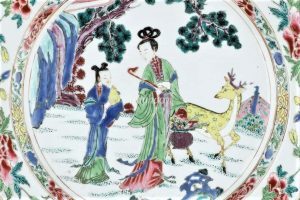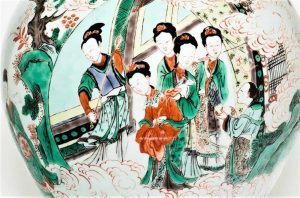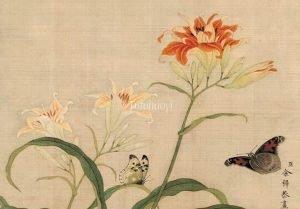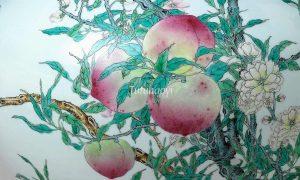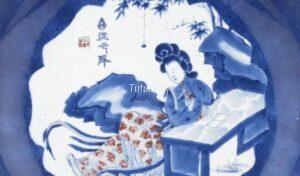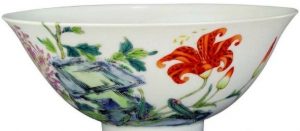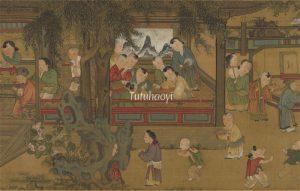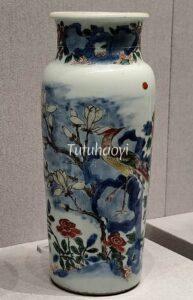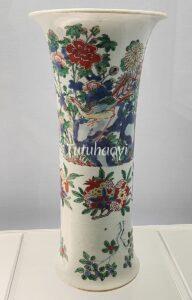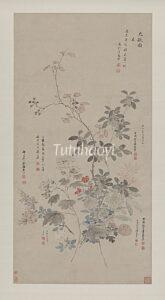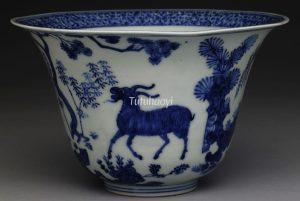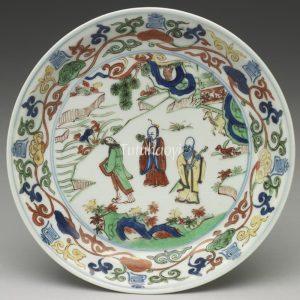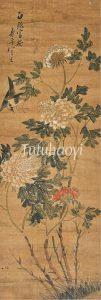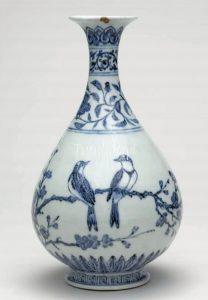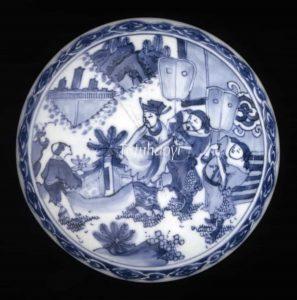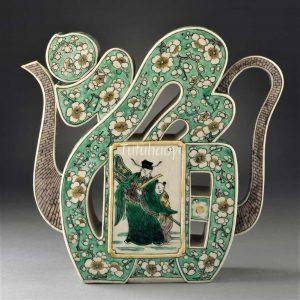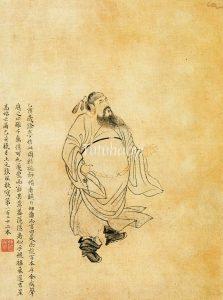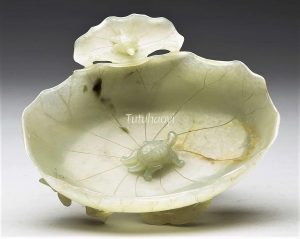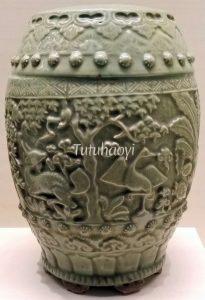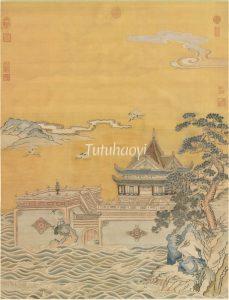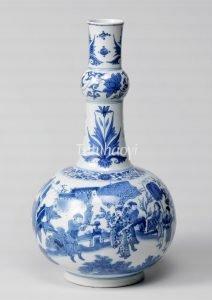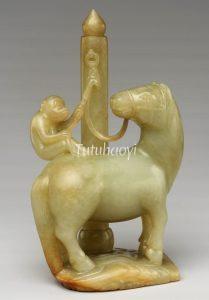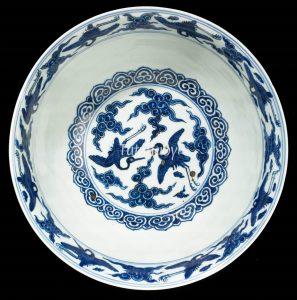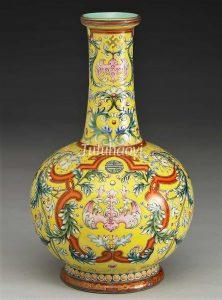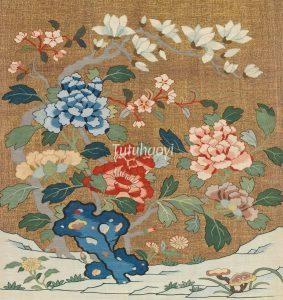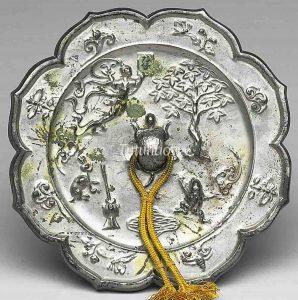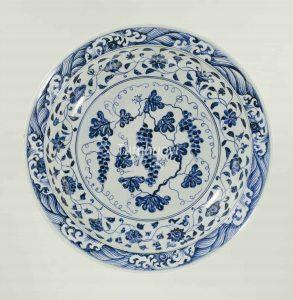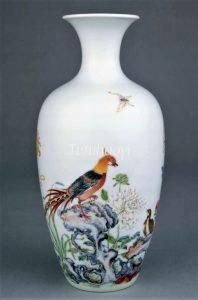Showing Results Containing
The Chinese Valentine’s Day, Qixi Festival (七夕节), is just around the corner. It falls on the seventh day of the seventh month of the traditional Chinese year. Dr Yibin Ni has conducted comprehensive research on this topic and has written an articl...
‘福 fu’, a Chinese character bearing an auspicious meaning of ‘good fortune’, has been used often in Chinese decorative arts. Dr Yibin Ni will tell you some interesting stories related to this character and how the intended meaning is represented i...
Chinese people deeply respect the elderly and traditionally consider a long existence to be one of the most important blessings in a person’s life. Here are many examples of how artists have combined a variety of longevity symbols to reinforce the...
In Chinese culture, the Mid-Autumn Moon Festival is related to the legendary fairy Chang E, the Moon Goddess. We often see a hare, her loyal companion, and an osmanthus tree in the picture with her against a background of the Moon Palace. However,...
On the seventh day of the seventh month of the lunar Chinese year, young men and women will celebrate their traditional ‘Valentine’s Day’, Qixi Festival (七夕节). The custom can be traced back to an ancient story.
More often than not, traditional Chinese motifs or symbols are not receiving their deserved attention, being given simplistic or inadequate labels and inaccurate explanations in our museums, catalogues, or even scholarly writing. The treatment of ...
Dr Yibin Ni has discussed the differences of symbolic meanings of lily between Western and Chinese cultures in his unique research, bringing new insight into pictorial art.
In Chinese culture and pictorial art, the peach fruit is often used to wish for long life on birthday parties. How does this fruit become associated with the idea of longevity? Here is Dr Yibin Ni explaining to us the origin of legendary stories r...
When you mistake a motif in a traditional Chinese picture, you could have misinterpreted the meaning of the whole image intended by the ancient craftsman. Dr Yibin Ni has used the following example to illustrate the hidden meaning of a series of i...
Are you afraid of small insects such as spiders? Why do we see this tidy dangling creature a popular motif used in traditional Chinese art? There is a secret here…
Is choosing a gift for your mother a difficult task? Not so much if your mother is a big fan of Chinese art. In traditional Chinese decorative arts, there are various images symbolising or referring motherhood. Lily flower is a typical exampleR...
The Hundred Children motif (百子图) represents the most elaborate and auspicious extension of the broader Children at Play theme in traditional Chinese art. While both mot...
Children at Play is a classical motif in traditional Chinese art, portraying lively scenes of children engaged in games and daily amusements. These depictions often feature children flying kites, kicking balls, turning somersaults, enjoying lanterns, performing lion or dragon dances, tending flowers, pla...
The Chinese character ‘大 da’ means ‘great’ or ‘grand’, and ‘吉 ji’ means ‘great fortune’ or ‘good luck’. In combination, ‘大吉 da ji’ expresses an auspicious wish of ‘May you enjoy great fortune’.
Related Pun Pictures:
The ‘Nine Autumn Flowers’ (Jiu Qiu Tu 九秋图) is a distinguished pattern in traditional Chinese decorative art, frequently employed to symbolise the richness and splendour of the autumn season. This theme features nine varieties of flowers, although not in a fixed set, collectively representing abundance, vitality,...
This is a legendary story about the birth of Confucius (551 BCE – 479 BCE), the renowned philosopher from ancient China during the Spring and Autumn Period (770 BCE – 475 BCE).
According to The Family History of Confucius (孔子家语), Confucius’ father, Shuliang He (叔梁纥), had nine daughters but no sons from hi...
Pun Design :
Three + Goat
Punning Details:
– In an ancient Chinese literature, The Book of Change (I-Ching 易经) that can be traced back to Western Zhou (1046–771 BCE), there are sixty-four different hexagrams (gua
‘Fu Gui Bai Tou 富贵白头’ is interchangeable with ‘Bai Tou Fu Gui 白头富贵’, with the same meaning of ‘May you enjoy wealth and high position ...
The figures of Three Star Gods are personified representation of Good Fortune, Prosperity, and
Pun Design:
Chinese bulbul + Peony
Punning Details:
– ‘bai tou 白头 white-headed’, of ‘bai tou weng 白头...
Pun Design:
Chinese bulbul + Two
Punning Details:
A pair of Chinese bulbuls in image imply the couple or the marriage;
‘bai tou 白头 white-headed’, of ‘bai tou weng 白头翁 Chinese bulbul’ (the white-headed-old-chap bird) can imply a ripe old age.<...
Fish (鱼 yu) puns with the word yu 余 meaning ‘abundance’, therefore it symbolises wealth and prosperity. Continue Reading
Pun Design:
Carrying on the Back + Monkey
Punning Details:
– ‘bei 背’ for ‘carrying on the back’ makes a pun on ‘bei 辈’ for ‘generation’
– ‘hou 猴’ from ‘hou zi 猴子’ for ‘monkey’ puns on ‘hou 侯’ for ‘marqui...
Pun Design :
Official Hat + Wine Vessel
Punning Details:
The combination of ‘jia 加 putting on’ and ‘guan 冠 hat’ – ‘jia guan 加冠’ is a pun on ‘jia guan 加官’, meaning ‘receiving an official title...
In this motif composition, the eight Daoist Immortals (ba xian 八仙) are not depicted in figural images, but rather are represented by their dist...
In the oracle bone script, the earliest form of the Chinese characters, the pictograph ‘福 (fu)’ consists of a pair of hands holding a wine jar in front of a sacred ancestral symbol. It means that, if the ancestors were pleased properly with right offerings, good fortune would come to bless the descendants.
<...The flying mammal bat is called bian fu (蝙蝠) in Chinese. Image of the bat including its various stylised forms are often used in Chinese art to express an auspicious meaning, as ‘蝠 fu
The character 龟 gui for ‘tortoise’ is explained in volume 13 of the annotated version of the oldest dictionary in China, Shuowen jiezi 说文解字注 (Explanations of Simple Graphs and Analyses of Composite Graphs). There is a quote from Liu Xiang (刘向, 77 BCE – 6 BCE), the Han-dynasty imperial librarian, i...
Yang Shen (杨慎, 1488–1559), alias Sheng’an (升庵), is a literatus and poet in the Ming dynasty (1368–1644). He recorded in Volume Ninety-Four of Sheng’an Additional Works a folklore anecdote: ‘In the northern dialect, there is no difference in sound between the he 合 for “coming together” and the he 鹤 for “...
In this scene, there are several Chinese longevity symbols such as the
The seventh day of the seventh month of the traditional Chinese year is the Chinese ‘Valentine’s Day’, Qixi Festival (七夕节). The custom can be traced back to an ancient story about a weaver girl and a cowherd:
Once upon a time, one of the daughters of the Lord of the Heaven lived on the east side of the Mi...
The main figure in the scene is a dignitary, often gripping a hu (笏) tablet in his hands, which an official uses to take notes when he has audience with the emperor in court. He is usually sheltered by page boys erecting some fans or a parasol or guarded by a soldier holding a weapon with an iron melon on the to...
A variation of 平升三级 ping sheng san ji (May you have three successive promotions unexpectedly) is 连升三级 lian shen...
The Chinese character for ‘monkey’ is 猴 hou and it puns on the word for ‘marquis’ in Chinese 侯 hou. The expression ‘mashang 马上’ in Chinese is ambiguous in that it can mean, literally, ‘on a/the horse’, or it can mean, idiomatically, ‘right away’. Therefore, an image of a monkey on the back of a...
The Ming-dynasty play The Story of the Blue Robe (青袍记 Qingpao ji, also called《梁氏父子传胪记》) tells the story of how Lv Dongbin (吕洞宾 Lü Dongbin or 吕纯阳), one of the Continue Reading
How the daylily, whose Chinese name is ‘xuan 萱’, came to become a symbol for motherhood in Chinese culture is explained in the blog ‘
Either the clockwise swastika 卐 or the counterclockwise sauwastika 卍 is used interchangeably in Chinese decorative arts as well as in some religious contexts. Sometimes, the two opposite versions can co-occur on the same occasion without making a difference in meaning. Swastika is a very old symbol in the cultures scatte...
According to the oldest dictionary in China, Shuowen jiezi 说文解字 (Explanations of Simple Graphs and Analyses of Composite Graphs), the earliest version of the character for ‘crane’ is a composite graph consisting of a pictograph for a bird, the present-day character niao 鸟, at the right, with feet and a ...
When swastika is combined with the Chinese character Continue Reading
Either the clockwise swastika 卐 (sounding ‘wan’ 万) or the counterclockwise sauwastika 卍 is used interchangeably in Chinese decora...
The Chinese deeply respect the elderly and consider a long existence – ideally accompanied by health and happiness – to be one of the five most important blessings (wufu 五福) in a person’s life, which were believed by the ancients and recorded in the Book of Documents 书经 in the Zhou Dynasty (...
The Chinese character ‘tian 天’ from the phrase ‘tianzhu 天竹’ for ‘nandina’ is both a homophone and homograph of the character ‘tian 天’ for ‘heaven’. The character ‘xian 仙’ in the phrase ‘shuixian 水仙’ for ‘narcissus’, is both a homophone and homograph of the character ‘xian<...
The character ‘yu 玉’ in ‘yulan hua 玉兰花’ for ‘magnolia’ is the same ‘yu 玉’ for ‘jade’. The word ‘tang 棠’ from ‘haitang hua 海棠花’ for ‘crabapple’ is homophonic with the word ‘tang 堂’ for ‘house’. The combination of the two characters ‘yutang 玉堂’ means ‘jade hous...
The peach fruit usually symbolises longevity or immortality in Chinese pictorial art. The origin of this idea started from legends dating back to the third century. Read Dr Yibin Ni...
This pun rebus picture consists of four essential pictorial elements: bird,
The ancient Chinese would employ a picture of a monkey reaching for a bee hive to wish their boss an imminent promotion. The word for bees in Chinese is ‘feng 蜂’ and the word for monkeys is ‘hou 猴’. When ‘feng’ and ‘hou’ are put together, they can form the phrase 封侯 which means ‘be bestowed a rank of nobility’ in Chinese...
In Zhuangzi (庄子), an ancient Chinese text from the late Warring States period (476–221 BCE) and one of the two foundational texts of Daoism, the Queen Mother of the West (Xiwangmu 西王母) was mentioned as a deity who ‘obtained the Dao (the Way)’. According to the Scripture of Great Peace (Tai...
The Mid-Autumn Moon Festival falls on the night of full moon in the eighth lunar month. Chang’e, the Moon Goddess, is usually associated with this family-union occasion, together with the festival food – the moon cake (月饼). A legend recorded in an ancient Chinese book, The Huainanzi (淮南子 The Discourses of the Hu...
The fifth creature of the Chinese zodiac, the long dragon is one of the most complex and multilayered of all Chinese symbols. Its ferocious energy binds together all the phenomena of nature: bringing benevolent rain, but also typhoons; shaping the landscape, and causing earthquakes. One of the guardian creatures...
Pun Design: Persimmons + Apples + Quails
Punning Details:
The Chinese character ‘shi 柿’ in ‘shi zi 柿子’ for ‘persimmon’...
Pun Design: Quails + seedheads of foxtail millet
Punning Details:
The word ‘sui 穗’ for ‘millet seedhead’ is a pu...
Pun Design: Apples + Continue Reading
Grapes grow in clusters of up to 300 berries each and thus produce an enormous number of seeds. This property was regarded by the ancient Chinese as an apt allusion to their wish for a large number of offspring. That is why grapes are seen adorning various kinds of Chinese antiques, handcrafts, and bric-a-brac, often, to...
Pun Design: Quail + Long-tailed Continue Reading


